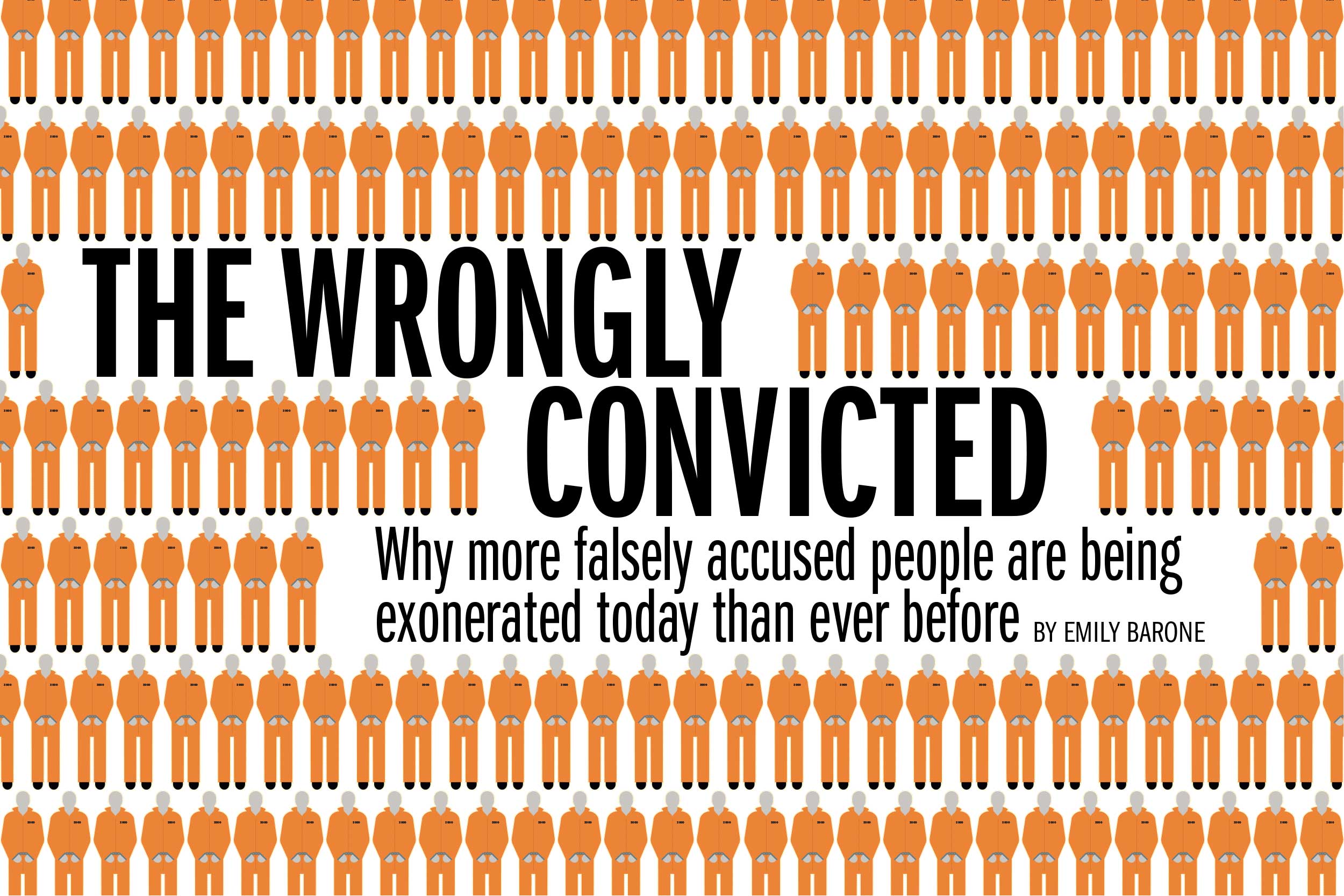For the third year in a row the number of exonerations in the United States has hit a record high. A total of 166 wrongly convicted people whose convictions date as far back as 1964 were declared innocent in 2016, according to a report from the National Registry of Exonerations released Tuesday. On average, there are now over three exonerations per week—more than double the rate in 2011.
The number of exonerations has generally increased since 1989, the first year in the National Registry’s database. There are 2,000 individual exonerations listed in the registry as of March 6.
Experts say the increase in rate of exonerations can be explained, in part, by a growing trend of accountability in prosecutorial offices around the country. Twenty-nine counties, including Chicago’s Cook County, Dallas County and Brooklyn’s Kings County have adopted second-look procedures and special review units that are tasked with looking into questionable convictions.
Historically, the convictions with the best chances of being overturned were those that got repeatedly reviewed on appeal or those chosen by legal institutions such as the Innocence Project and the Center on Wrongful Convictions. These cases tended to be high profile cases with defendants who received severe sentences.
The recently established conviction review units, on the other hand, designate resources to both violent and nonviolent crimes like drug offenses. These offices have been involved in 225 exonerations, 70 of which were last year. Thanks largely to these cases, nonviolent crimes accounted for more exonerations (44%) than murder and manslaughter exonerations (33%) in 2016.
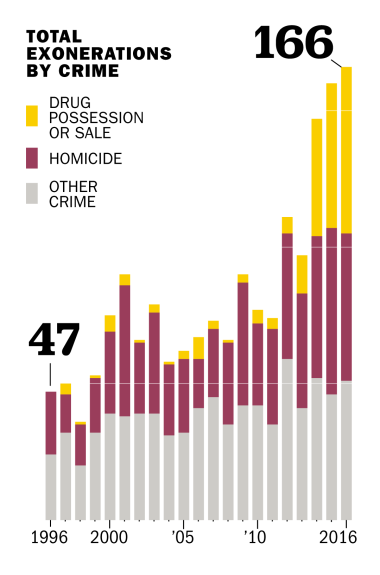
The review units “reflect a growing recognition of the importance of the problem,” says Samuel Gross, a law professor at the University of Michigan who is co-founder and senior editor of the National Registry. “Many prosecutors, police officers and judges have learned that sending innocent people to prison is a constant risk—not a once-in-a-lifetime novelty.”
Many point to changes in places like Harris County, Texas, home to the city of Houston, where the county’s conviction review unit has totaled 128 exonerations, or 15% of all exonerations in the U.S., since 2010, the first full year it was in operation. Harris County identified a problem that is likely systemic across the U.S. and has actively spent the last two years trying to right its wrongs.
It started in 2014, when a reporter from the Austin American-Statesman reached out to the district attorney’s office to ask about something he had noticed: a steady stream of years-old drug convictions were being overturned. In many of these cases, the so-called drugs were actually legal substances like over the counter medications that had been initially misidentified by faulty field test kits.
The field tests, which have been around since the 1970s and cost $2, are simple chemical cocktails that change color when illegal drugs like cocaine are added. But the color also changes when exposed to dozens of other compounds, yielding a false positive.
The district attorney’s office ascertained that there was a backlog of these drug cases in which the defendant had pleaded guilty. As ProPublica and The New York Times Magazine reported in great detail last year, the county worked to streamline the process of reexamining these cases, kicking off a mass reversal of convictions over the next two years. In addition, Harris County now no longer accepts guilty pleas in drug cases until the substance has been tested in a lab.
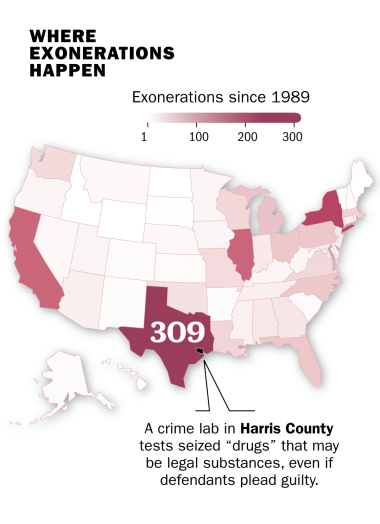
What’s remarkable about Harris County is that the crime labs there have tested suspected drugs even after a guilty plea. According to Gross, this is not done in many other major counties. And in many jurisdictions, evidence is destroyed once a defendant pleads guilty.
“If other labs did what they do in Houston, we’d see thousands of similar cases across the country,” he says.
Kim Ogg, who was sworn in as Harris County’s District Attorney in January, says that she plans to keep the conviction review unit open in order to make the judicial system more trustworthy. In total, she says, the office has alerted 317 individuals in drug cases where no controlled substance was found and 148 cases are still pending.
“We take every case of wrongful conviction seriously,” Ogg says. “It’s a threat to the public trust.”
Now other counties are reacting. Las Vegas’s Clark County, for instance, established a conviction review unit in October, the same month that ProPublica and the Las Vegas Review-Journal exposed that, like Harris County, the Clark County district attorney’s office convicted defendants on the basis of field test evidence in recent years despite knowing that the tests have a high error rate.
Data from the National Registry shows that more than half of exonerations involve perjury or false accusations. This problem is particularly prevalent in homicide cases and child sex abuse cases. Mistaken witness identification is often an issue in sexual assault cases.
DNA has played a role in roughly a quarter of exonerations since 1989, the year it was first used to clear David Vasquez, who was falsely convicted of murder in Arlington County, Va. In the last decade the number of DNA exonerations has held steady at about 20 cases per year. (Biological evidence is typically tested before trial so the majority of DNA-related exonerations these days are for convictions that happened decades ago.)
But these reasons don’t fully explain why so many false convictions are happening in the first place. There are underlying issues in the law enforcement and criminal justice system that run far deeper, says Gross.
“If you fix problems like the drug tests, that’s a good thing,” says Gross. “But then the question is why were you stopped in the first place? Why were you asked to step out of the car? And why were you searched? That’s the real question.”
A second report released Tuesday authored by Gross points to the apparent racial disparity in wrongful convictions. Gross’s analysis found that almost half of the exonerations in the national database are black defendants, compared with 39% who are white.
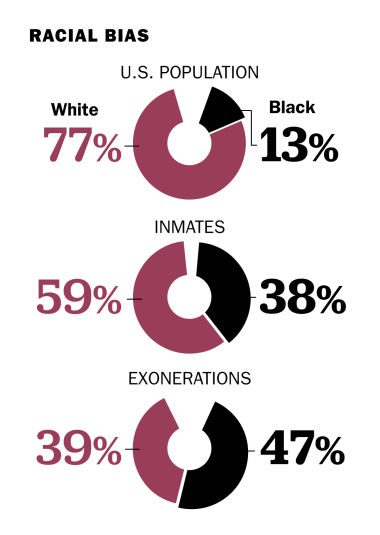
Racial bias is particularly stark in cases where numerous defendants were exonerated together. Separate from the individual exonerations listed in the National Registry, an additional 1,840 defendants have been cleared in 15 “group” exonerations across the country since 1989. The great majority of these groups were framed for drug cases that never happened and, likewise, a great majority of these groups were predominantly black.
Other racial biases are evident in Gross’s analysis. For instance, sexual assaults by black men on white women are a small minority of all sexual assaults in the U.S., but they make up half of sexual assaults with eyewitness misidentification.
Other disturbing trends reinforce the widely-documented racial bias that blacks face at every step of the system. They are more likely to be targets of police misconduct. They receive harsher sentences than whites for the same crimes. And, for violent crimes like murder and sexual assault, they spend several years longer in prison before exoneration.
Other studies from academic institutions and the federal government have also highlighted racial disparities in law enforcement and sentencing. The Justice Department, for example, released a study in 2015 that found black men received roughly 5% to 10% longer prison sentences than white men for similar crimes.
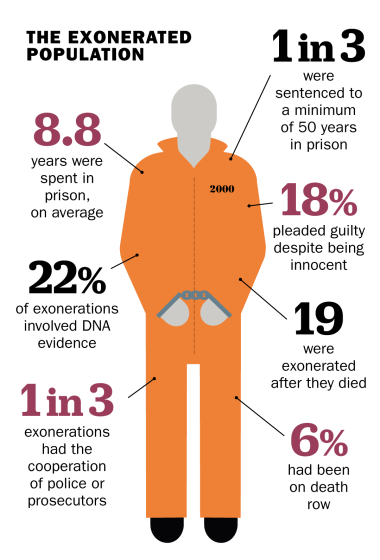
Former Attorney General Loretta Lynch elevated issues of race during her tenure under President Obama and last year implemented a bias recognition training program for all federal law enforcement divisions as well as the 94 U.S. Attorney’s Offices in the country.
“You have situations where you can see people are treated differently,” Lynch said last year when speaking at Harvard Law School on the subject of racial bias in law enforcement.
Lynch’s predecessor, Eric Holder, similarly acknowledged racial disparities. In a 2014 video message he said, “This overrepresentation of young men of color in our criminal justice system is a problem we must confront—not only as an issue of individual responsibility but also as one of fundamental fairness, and as an issue of effective law enforcement.”
Black, white or any other race, it’s hard to pinpoint exactly how many convicted defendants may actually be innocent. In attempt to answer this question, Gross published a paper in 2014 that estimated 4.1% of people on death-row are innocent while only 1.8% of them have been exonerated.
These estimates are based on a mathematical model that takes into account the number of death-row inmates who would have been exonerated had they not been executed, died in prison or had their sentences reduced. (Life-sentence cases receive far less scrutiny and are therefore less likely to be overturned than death-row cases.) Gross stands by those figures today.
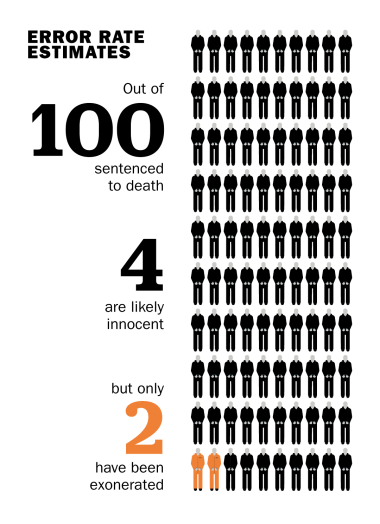
For the broader population of convicts who are not on death row, Gross can only say that the 2,000 vindicated people in the National Registry represent a small fraction of those who are actually innocent.
That means many thousands of people could have served time or are in prison today for crimes they did not commit while the real criminals remain free. And for the few who do get exonerated, it’s unlikely that their lives just go back to normal.
“Even those who are eventually freed have lost large parts of their lives—their youth, the childhood of their children, the last years of their parents’ lives, their careers, their marriages,” Gross says. “False convictions wreak havoc in every direction.”
GRAPHICS SOURCES: National Registry of Exonerations as of March 6, 2017; “Rate of False Conviction of Criminal Defendants who are Sentenced to Death,” PNAS, 2014; Census; Bureau of Prisons
NOTES: Map figures exclude federal prosecutions, Puerto Rico and Guam. Exonerations by race do not include individuals who identify as Hispanic or Latino. Death-row innocence estimates calculated from all death-sentence defendants from 1973 to 2004.
